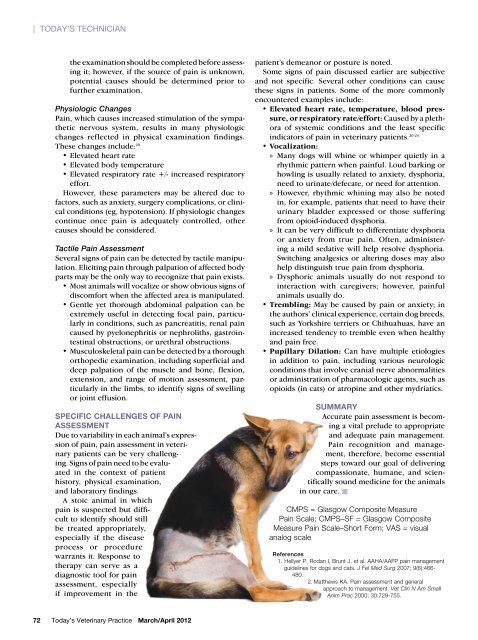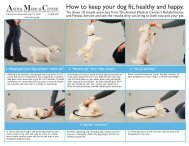Physical Physical - Tripawds Downloads
Physical Physical - Tripawds Downloads
Physical Physical - Tripawds Downloads
- No tags were found...
Create successful ePaper yourself
Turn your PDF publications into a flip-book with our unique Google optimized e-Paper software.
| Today’s Technicianthe examination should be completed before assessingit; however, if the source of pain is unknown,potential causes should be determined prior tofurther examination.Physiologic ChangesPain, which causes increased stimulation of the sympatheticnervous system, results in many physiologicchanges reflected in physical examination findings.These changes include: 20• Elevated heart rate• Elevated body temperature• Elevated respiratory rate +/- increased respiratoryeffort.However, these parameters may be altered due tofactors, such as anxiety, surgery complications, or clinicalconditions (eg, hypotension). If physiologic changescontinue once pain is adequately controlled, othercauses should be considered.Tactile Pain AssessmentSeveral signs of pain can be detected by tactile manipulation.Eliciting pain through palpation of affected bodyparts may be the only way to recognize that pain exists.• Most animals will vocalize or show obvious signs ofdiscomfort when the affected area is manipulated.• Gentle yet thorough abdominal palpation can beextremely useful in detecting focal pain, particularlyin conditions, such as pancreatitis, renal paincaused by pyelonephritis or nephroliths, gastrointestinalobstructions, or urethral obstructions.• Musculoskeletal pain can be detected by a thoroughorthopedic examination, including superficial anddeep palpation of the muscle and bone, flexion,extension, and range of motion assessment, particularlyin the limbs, to identify signs of swellingor joint effusion.sPeCifiC ChAllenGes of PAinAssessMentDue to variability in each animal’s expressionof pain, pain assessment in veterinarypatients can be very challenging.Signs of pain need to be evaluatedin the context of patienthistory, physical examination,and laboratory findings.A stoic animal in whichpain is suspected but difficultto identify should stillbe treated appropriately,especially if the diseaseprocess or procedurewarrants it. Response totherapy can serve as adiagnostic tool for painassessment, especiallyif improvement in thepatient’s demeanor or posture is noted.Some signs of pain discussed earlier are subjectiveand not specific. Several other conditions can causethese signs in patients. Some of the more commonlyencountered examples include:• Elevated heart rate, temperature, blood pressure,or respiratory rate/effort: Caused by a plethoraof systemic conditions and the least specificindicators of pain in veterinary patients. 20-24• Vocalization:» Many dogs will whine or whimper quietly in arhythmic pattern when painful. Loud barking orhowling is usually related to anxiety, dysphoria,need to urinate/defecate, or need for attention.» However, rhythmic whining may also be notedin, for example, patients that need to have theirurinary bladder expressed or those sufferingfrom opioid-induced dysphoria.» It can be very difficult to differentiate dysphoriaor anxiety from true pain. Often, administeringa mild sedative will help resolve dysphoria.Switching analgesics or altering doses may alsohelp distinguish true pain from dysphoria.» Dysphoric animals usually do not respond tointeraction with caregivers; however, painfulanimals usually do.• Trembling: May be caused by pain or anxiety; inthe authors’ clinical experience, certain dog breeds,such as Yorkshire terriers or Chihuahuas, have anincreased tendency to tremble even when healthyand pain free.• Pupillary Dilation: Can have multiple etiologiesin addition to pain, including various neurologicconditions that involve cranial nerve abnormalitiesor administration of pharmacologic agents, such asopioids (in cats) or atropine and other mydriatics.suMMARyAccurate pain assessment is becominga vital prelude to appropriateand adequate pain management.Pain recognition and management,therefore, become essentialsteps toward our goal of deliveringcompassionate, humane, and scientificallysound medicine for the animalsin our care. ■CMPS = Glasgow Composite MeasurePain Scale; CMPS–SF = Glasgow CompositeMeasure Pain Scale–Short Form; vAS = visualanalog scaleReferences1. Hellyer P, rodan i, Brunt J, et al. AAHA/AAFP pain managementguidelines for dogs and cats. J Fel Med Surg 2007; 9(6):466-480.2. Matthews KA. Pain assessment and generalapproach to management. Vet Clin N Am SmallAnim Prac 2000; 30:729-755.72Today’s Veterinary Practice March/April 2012






